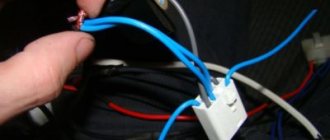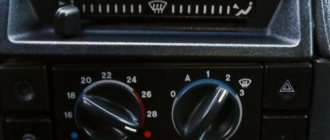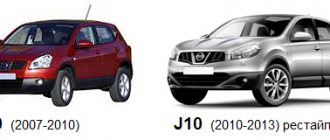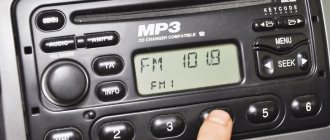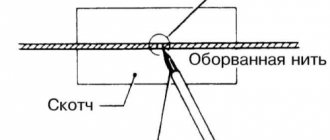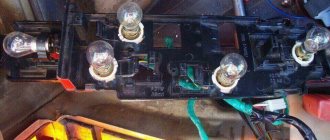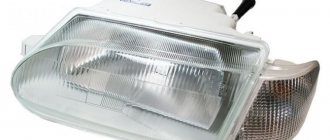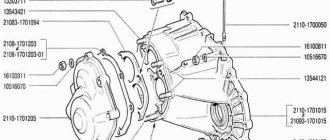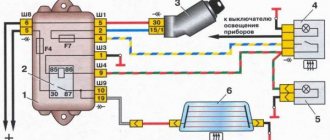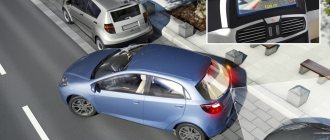Before moving off, carefully study the gear shift pattern and practice shifting gears with the engine not running. Gear shift diagrams are shown in Fig. 1. Using the gear shift lever, the driver can discretely transmit torque from the engine to the wheels of the car. The first gear is the most powerful, transmits the highest torque and is used for starting from a standstill, overcoming difficult sections of the road, and when driving uphill with a large load.
The speed in this gear is up to 40 km/h. Second, third and fourth gears respectively transmit less torque. The crankshaft rotation speed decreases, and the wheel rotation speed increases. The second gear is used to accelerate the car and move it at speeds from 20 to 60 km/h. The third gear is used to accelerate and move the car at speeds from 30 to 90 km/h. Fourth gear (direct) creates less torque and has the largest speed range, from 40 km/h to maximum.
The fifth gear has a reduced gear ratio of 0.70.8. The crankshaft rotates at a lower speed than the wheels. This economical transmission is used for straight sections of the road, without heavy loads, since it is very weak. The reverse gear is also powerful and transmits a lot of torque and has a large gear ratio. It is used for reversing. The neutral position of the gear shift lever disengages all gears.
To engage reverse gear, press the clutch pedal and, after holding for 3 seconds, press the gear shift lever all the way and move it to the reverse gear position. Everyone must learn to move a car away smoothly in compliance with a certain sequence, safety requirements and traffic rules. A little theory. When moving, a car overcomes a number of forces that create resistance to its movement.
The main forces are: the rolling resistance force of the wheels, the air resistance force, the inertia force and the lifting resistance force. The movement of the car is ensured when the adhesion force between the wheels and the road is equal to or greater than the traction force. If the traction is greater than the traction force (the ten has more traction force than most other domestic cars), then the drive wheels will slip. In this case, a large load is placed on the clutch and gearbox, which can quickly fail. Fans of a sporty driving style should especially remember this. On the 10, the gearbox is not from a Mercedes.
When starting off on a flat section of the road, you only need to overcome the rolling resistance force of the wheels and the force of inertia. Before you set off, you must: depress the clutch pedal (develop this habit, it will allow you to avoid many troubles); turn on the ignition; start the engine; carefully inspect the road you intend to enter through the rear-view mirrors, external and internal, and turn your head left and right to check the blind spot from behind and from the sides; Turn on the turn signal if you are sure it is safe. You should not turn on the turn signal if there are other vehicles or pedestrians nearby to whom you must give way; With your left foot, fully depress the clutch pedal and hold it in this position.
The clutch pedal must be pressed sharply, this disengages the clutch, disconnects the rotation of the crankshaft and the input shaft of the gearbox; Hold the steering wheel with your left hand, and with your right hand move the gear shift lever to the first or second gear position (when it is necessary to engage second gear, we will consider below). Comment. The first (second) gear may not engage immediately; there is no need to try to push it in by force. Move the gear shift lever to the neutral position, release the clutch pedal, depress the clutch pedal all the way again and repeat engaging the first (second) gear. At the same time, the gears of the gearbox have turned and the gear should engage easily; again carefully inspect the road through the mirrors and left shoulder, make sure it is safe once again; If you can start moving, then release the parking brake lever down; lightly press the gas pedal with your right foot; feel the crankshaft speed increase slightly.
This is especially clearly visible on the tachometer; With your left foot, slowly and gently release the clutch pedal, gradually turn it on and smoothly transmit torque from the engine crankshaft through the first gear of the gearbox to the wheels, while the crankshaft rotation speed from the load will begin to decrease. You can hear it from the engine noise or see it from the tachometer; hold the clutch pedal at the end and lightly press the gas pedal, increasing the crankshaft speed and traction force, which begins to overcome the rolling resistance of the wheels and the force of inertia; the car starts moving smoothly; After starting to move, continue to smoothly release the clutch pedal all the way, then be sure to remove your foot from the pedal. The clutch pedal in first gear must be released smoothly, held at the end, and then smoothly released to the end. When starting off, drivers mainly make two mistakes, which lead to a strong jerk or stopping of the engine. Reasons for the first error: sharp release of the clutch pedal and strong pressing of the gas pedal (high crankshaft revolutions lead to a strong jerk of the car, and on a slippery road and for drivers with a sporty driving style and on dry asphalt, it leads to wheel slipping ). Eliminating the error if the engine does not stall: sharply depress the clutch and reduce the pressure on the gas pedal and reduce the crankshaft speed.
Repeat the move. Pay attention to the smooth release of the clutch pedal and less pressure on the gas pedal. Reasons for the second error: abrupt release of the clutch pedal and weak pressure on the gas pedal, low crankshaft speed. Error elimination: restart the engine. At the same time, pay attention once again to the smooth release of the clutch pedal and the stronger pressure on the gas pedal compared to the first attempt.
When using two clutch and gas pedals in concert, lightly pressing and releasing the gas pedal should always be slightly ahead of pressing and releasing the clutch pedal. It’s easier to get moving in the top ten with the 2112 engine installed. When starting off, you don’t have to press the gas pedal. This makes management easier. The car picks up speed without high revs. And the traction reserve allows you to change gears less often.
Taken from: https://2110-2112.ru.
Like any car, the VAZ 2110 also has a gear shift mechanism. The VAZ gearbox is five-speed, activated by a lever located in the car's interior.
In order to be able to fix problems yourself, you need to understand a little about how exactly the switching mechanism works, which is why there are cases when some speed does not turn on or goes out. And also know how to fix it on your own.
Checkpoint diagram
The gearbox design is as follows:
- To ensure gear shifting, the gearbox contains a primary shaft consisting of a gear block. They are constantly engaged with the drive gears from the first to the fifth speed (that is, those that are oriented towards driving forward);
- The secondary shaft is equipped with a drive gear for the main transmission, and it also has gear synchronizers that ensure forward movement of the driven gears. There are also bearings plus an oil sump;
- VAZ two-satellite differential, with the driven gear of the main gear attached to the flange of its box;
- the gearbox drive consists of a gear shift knob, a ball joint, a selector rod, a rod, gear selection mechanisms, and gear shifting mechanisms;
- Jet thrust is designed to protect the gearbox from flying out of gear. Its ends are attached to the support and the power unit.
How to change gears on a manual transmission
To switch to a lower speed, release the gas pedal and press the brake until the car slows down to the desired speed, then squeeze the clutch and switch to the desired speed, release the clutch and press the gas pedal. When downshifting, always reduce the speed of the car - if you engage a low gear at high speed, the car will brake sharply and may skid. Also, when changing gears, you must fully depress the clutch - otherwise you will hear a characteristic grinding sound in the box, and over time it will completely fail.
Before you start practicing, you need to have some knowledge about the mechanical box. Most manual transmissions have 4 or 5 gears and one reverse, and there is also a neutral one, when engaged, no torque will be transmitted to the wheels. From the neutral position you can change to any gear, including reverse. Be sure to learn the location of the gears so that you don’t have to look at the gearshift lever while driving. 1st gear is used more for starting or when parking the car. You need to be careful with the rear one - it has a larger speed range than the first one, and with prolonged use it can damage the box.
Adjustment
On a VAZ 2110, it is not so uncommon for the gears to shift poorly or get knocked out. A mechanism for adjusting the speed selection drive is provided specifically for this purpose.
Adjustment may be necessary if:
- the box was recently removed for repairs;
- one of the gears falls out;
- the speeds do not engage well or simply get knocked out when the car is moving.
If you have one of these problems, try making adjustments first. Its sequence:
- Under the bottom of the VAZ 2110, find and slightly loosen the nut on the bolt that tightens the clamp that secures the rod designed to control the gearbox;
- Use a screwdriver to slightly move apart the grooves in the end of the rod and the resulting gap on the clamp itself. This is necessary to ensure easy movement of the rod in relation to the gear selection rod. Place the rod in the neutral position;
- Release the shift knob from the cover in the cabin;
- Align the lever using a special template. This is done like this: install a template in the window of the rear speed lock bracket lining. After this, insert the lever axis stop into the groove of the template, pressing it without unnecessary force in the transverse direction;
- Then adjust the axial play of the rod in the rear direction, and its axial play by turning to the left;
- Install the clamp, not reaching a few millimeters from the end of the rod. Then tighten the clamp thoroughly with the bolt.
Driving technique – shifting gears “down”
Shifting gears in order, from 1st to 5th, is called upshifting. This article will tell you the advice of a driving instructor about switching in the reverse order, or switching “down”.
All sources on driving a car, as well as all instructors, constantly repeat that it is necessary to take a turn with the gear engaged. This is really correct. While driving, it should always be possible to reduce the speed (braking), as well as increase the speed. It is to increase speed that you need the gear engaged. But in what gear should you take the turn? Everything here is logical and simple - the gear must be one that is consistent with the speed of the car.
Before we continue talking about the gear “number,” let’s talk a little about cornering speed. When driving in the city, turning at an intersection at a speed exceeding 30 km/h is highly discouraged due to the presence of other cars and pedestrians. It all depends on the turning radius, visibility, the number of directions to which you need to pay attention, and so on. And if you select a gear that is too high, the engine will not be able to cope with the load, causing the car to jerk. Of course, you can not attach any importance to this and buy, for example, a sofa for your cabin to make the ride softer, but it is better to master the selection of gears for different speeds.
Let's say you want to make a turn at a speed of 25 km/h. And in what gear? On the second"? Why exactly “second”? Everything here is also simple, most car manuals indicate that you need to move in second gear at a speed of 15-20 km/h to 40 km/h. Therefore, it turns out that in almost all cases the turn must be negotiated in “second” gear.
When you make a downshift, you should keep in mind that this can only be done at a certain vehicle speed. If you neglect this rule when switching “up”, then nothing terrible or irreversible will happen, but switching “down” is a special case. If you forcefully engage, for example, “second” gear at high speed, you can easily damage the car’s gearbox, or very seriously damage the engine. “Second” gear can be engaged at high speed only when you need to brake urgently. In normal situations, only the gear that is consistent with the speed of the vehicle is engaged.
If you need to engage the “second” gear, you must first reduce the speed to 40 km/h or lower. And making a turn at 65 km/h is not the smartest decision, since your main attention will be paid to controlling and combating the inertia of your car, and not to the road situation around you. Such a turn can bring you a lot of trouble. Therefore, until you have professional skills, you should not perform such dangerous experiments, and you should not try to take city turns at high speeds.
From the above we have learned that in order to avoid breaking the gearbox, it is necessary to reduce the speed before switching from “third” or “fourth” to “second”. And the speed of the car should not be higher than 40 km/h.
Most likely, many people now have a question: how can I find out the speed at which my car is traveling just before switching? Yes, as they say, “by eye”, it is quite difficult to determine the speed without proper experience, but it is for such purposes that your car has a special device that shows the speed of the car with an arrow on a scale or numbers on the LCD screen, and it is called - "Speedometer". The name of this device comes from the English word “speed”, which means speed in Russian. This device is located on the dashboard of any car. You need to find it there, and sometimes look at it, both before making a turn and when moving straight. The most important thing is that you should not look at this interesting device for a long time, as this can distract you from the most important thing - the road.
So, having analyzed everything written above, we can literally list point by point what needs to be done when shifting gears “down” before turning.
1. We start braking in order to slow down. The clutch does not need to be depressed for engine braking to help.
2. We make sure that our speed enters the range at which it is recommended to engage “second” gear.
3. Depress the clutch pedal and engage second gear.
4. Slowly release the clutch and pause at the engagement point for 2-3 seconds.
5. After a delay, completely smoothly release the clutch and either continue to brake or increase the speed.
In the end, it is worth answering one more question that you will probably have during practical driving of a car. Is it correct and is it possible to shift the gear down while skipping one or two positions? Answer: yes, you can. You can switch from “fifth” directly to “first”, but you definitely need to slow down the car to the desired speed. If the situation on the road allows you to brake to engage the “first” gear immediately, without intermediate shifts, for example from 90 km/h to 10 km/h, then you can and should engage the “first” gear, since apart from the “first” gear, there is no other and doesn't fit.
If you just got behind the wheel, be sure to read how to drive in winter. This is useful advice for beginners.
How to wash a car
What do you need to know before washing your car? For sinks...
Driving through unregulated intersections of equivalent roads
For most drivers without driving experience it is always difficult...
Little driving tricks
In order to save nerves and material resources,…
Driving schools
Today it is almost impossible to imagine a modern person...
How to start a car correctly in cold weather
In case of sudden temperature changes, severe frosts, start...
What is included in a car first aid kit
What is included in the basic composition of a new car first aid kit...
Road safety activities for novice drivers
The concept of safe traffic on the roads is based on the…
Exercise garage at the race track
Of course, after you can successfully pass the theory...
Lesson 3
- clutch not fully depressed (crunching noise when changing gears);
- inaccurate switching path (lever movements should be straight and move at right angles, not diagonally);
- incorrect selection of the moment of switching (too high a gear - the car will start to twitch or even stall, too low a gear - the car will roar and most likely “peck”).
The figure below shows a gear diagram that is repeated on most cars, with the exception of reverse gear. Very often, reverse gear is located in the area of first gear, but to engage it, you most often need to lift the lever.
27 Jun 2020 stopurist 319
Share this post
- Related Posts
- What buildings on a summer cottage are subject to registration in 2020
- How to communicate with debt collectors, legal advice 2020
- Repairs can be done on Saturday in Moscow
- Help from the State to the Poor Yf Gjufitybt Bgjntrb
How does 5G work?
Now that we know what 5G is, it's useful to understand how it works, as it is different from traditional 4G LTE.
Unlike LTE, 5G operates in three different spectrum bands. While this may not seem important, it will have a significant impact on your daily use.
- Low frequency spectrum can also be described as the spectrum below 1 GHz. This is the main band used by telecom operators for LTE. While low-frequency spectrum offers greater coverage and wall penetration, there is a big drawback: peak data rates will exceed 100 Mbps.
- The mid-frequency spectrum offers faster speeds and lower latency than the low-frequency spectrum. However, it is not able to penetrate buildings as effectively as low frequency spectrum. Expect peak speeds of up to 1 Gbps in the mid-band spectrum.
- High-frequency spectrum is what delivers the highest performance for 5G, but it comes with significant downsides. This is often referred to as mmWave . High frequency spectrum can offer peak speeds of up to 10 Gbps and has extremely low latency. The main disadvantage of the high frequency band is that it has low coverage area and poor penetration into buildings.
5G coverage for operators will allow the use of LTE while work is underway to create nationwide networks. Because high-frequency spectrum sacrifices the creation of penetration and coverage for high speed, it will rely on many small cells. These are low-power base stations that cover small geographic areas and can be combined with beamforming to enhance coverage.

